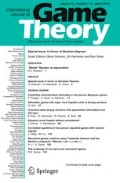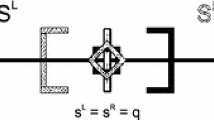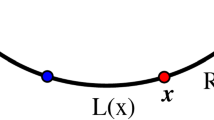Abstract
We investigate the strategic behavior of firms in a Hotelling spatial setting. The innovation is to combine two important features that are ubiquitous in real markets: (1) the location space is two-dimensional, often with physical restrictions on where firms can locate; (2) consumers with some probability shop at firms other than the nearest. We characterise convergent Nash equilibria (CNE), in which all firms cluster at one point, for several alternative markets. In the benchmark case of a square convex market, we provide a new direct geometric proof of a result by Cox (Am J Political Sci 31:82–108, 1987) that CNE can arise in a sufficiently central part of the market. The convexity of the square space is of restricted realism, however, and we proceed to investigate grids, which more faithfully represent a stylised city’s streets. We characterise CNE, which exhibit several new phenomena. CNE in more central locations tend to be easier to support, echoing the unrestricted square case. However, CNE on the interior of edges differ substantially from CNE at nodes and follow quite surprising patterns. Our results also highlight the role of positive masses of indifferent consumers, which arise naturally in a network setting. In most previous models, in contrast, such masses cannot exist or are assumed away as unrealistic.












Similar content being viewed by others
Notes
Competition on graphs has also been studied in the context of Voronoi games, a broad class of facility location selection games. Two or more players, simultaneously or in turns, select one or more facility locations to maximise their share of the market. It is often assumed that customers and firms are only located at nodes (e.g., Dürr and Thang 2007; Mavronicolas et al. 2008; Feldmann et al. 2009; Sun et al. 2020), that indifferent consumers do not shop anywhere (Sun et al. , 2020), or the game is very different in other ways. To our knowledge, consumers always go to the nearest firm, although some authors study diffusion processes which are very different in practical terms (Alon et al. 2010; Roshanbin 2014), yet conceptually within a similar ballpark. Often, the focus is on the computational complexity of algorithms for calculating solutions (e.g., Teramoto et al. 2011; Bandyapadhyay et al. 2015).
The results are invariant to affine transformations of \(\mathbf{p}\). Therefore for readability we often do not require the probabilities add to one.
An alternative interpretation is that \(p_i\) represents the number of units a customer demands from the ith nearest firm.
This is why we will sometimes refer to the probability vector \(\mathbf{p}\) as a rule. Plurality, antiplurality and Borda rule are given by \(\mathbf{p}=(1,0,\ldots ,0)\), \(\mathbf{p}=(1,1,\ldots ,1,0)\) and \(\mathbf{p}=(m-1,m-2,\ldots ,1,0)\), respectively, and their corresponding values of \(c(\mathbf{p},m)\) are \(1-1/m\), 1/m and 1/2.
We believe that, in particular, sharp discontinuities in the probability with which a consumer shops at a firm as it changes in ranking are a realistic feature. That is, for a given consumer, if firm i moves further away than another firm, there should be a jump in the probability of shopping at firm i. In probabilistic models such as those of De Palma et al. (1990), Lin et al. (1999), or Adams (1999), the probability the consumer goes to firm i is continuous as i moves beyond another firm, which is also not entirely realistic. Of course, the ideal model would depend on both rank and distance.
Theorem 1, below, in fact applies even more generally to situations where the numbers \(K_{u\succ v}\), \(K_{v\succ u}\) and \(K_{u\sim v}\) may not be generated by a metric. For instance, suppose customers prefer firms that are within some “walking distance”, as defined by a metric, over firms that are not within walking distance. Additionally, consumers are indifferent between two firms within walking distance or between two firms that are outside of walking distance. The key thing is that we can always partition the space into these three groups of consumers.
Even on the simple unit interval, NCNE are much more complicated than CNE, as can be seen in Cahan and Slinko (2017) and Cahan et al. (2018). Assuming customers always go to the nearest firm, Fournier and Scarsini (2019) have made progress studying NCNE on networks. They show that NCNE exist once the number of firms is sufficiently large, and the NCNE they describe are quite complex in structure.
In our contexts, reasonable non-uniform distributions of consumers would thus retain the flavour of the results, but the specific formulas we derive would no longer apply. Note that uniform distributions are not necessarily unrealistic—they are consistent with firms that believe or assume the distribution is uniform as discussed by Aragonès and Xefteris (2012) and Cahan and Slinko (2017).
These results have interesting implications for the political interpretation of the star network as mentioned in the Introduction. Equilibria where no candidates advocate for favouring any one group are sustainable under plurality provided the number of candidates is not too large, but they are always sustainable for rules with \(c(\mathbf{p},m)\le 1/2\) such as antiplurality. On the other hand, plurality has the advantage that equilibria where one group is favoured never exist. For antiplurality, it is possible to sustain equilibria where all candidates advocate in favour of one group, which is likely undesirable. Borda looks particularly good in that it always allows CNE at the central node but never anywhere else.
It is interesting to note parallels with probabilistic voting models (De Palma et al. 1990; Lin et al. 1999; Adams 1999) that find that CNE tend to exist in situations with greater uncertainty. These situations, roughly speaking, are qualitatively similar to settings where customers are likely to shop at more distant firms, i.e., where \(c(\mathbf{p},m)\) is low and CNE are thus likely.
They additionally assume that firms and consumers only locate at nodes and that indifferent consumers do not go to any firm, which is very different to our model.
Clearly, a move even further along would decrease \({K_{u'\succ u}}/{K_{u\succ u'}}\)—once we pass the node \((x-1,y)\), moving further to the left implies a loss along all the edges between \((x-1,z)\) and (x, z) for all z.
Note that if \(y\ge x\), \(|SE|\ge |NW|\), so the move to \((x-1+\epsilon ,y-1)\) is better than the move to \((x-1,y-1+\epsilon )\) and we only need one comparison.
Moreover, from the point just west of \((x-1+\epsilon ,y-1)\), it would not be desirable to continue deviating along that edge because the number of edges from which the firm is losing consumers exceeds the number from which it is gaining consumers.
References
Adams JA (1999) Multiparty spatial competition with probabilistic voting. Public Choice 99:259–274
Ahlin C, Ahlin PD (2012) Product differentiation under congestion: Hotelling was right. Econ Inq 51:1750–1763
Alon N, Feldman M, Procaccia AD, Tennenholtz M (2010) A note on competitive diffusion through social networks. Inf Process Lett 110:221–225
Anderson S, Kats A, Thisse J-F (1994) Probabilistic voting and platform selection in multi-party elections. Soc Choice Welf 11:305–322
Aoyagi M, Okabe A (1993) Spatial competition of firms in a two-dimensional bounded market. Reg Sci Urban Econ 23(2):259–289
Aragonès E, Xefteris D (2012) Candidate quality in a Downsian model with a continuous policy space. Games Econ Behav 75:464–480
Bandyapadhyay S, Banik A, Das S, Sarkar H (2015) Voronoi games on graphs. Theor Comput Sci 562:270–282
Cahan D, Slinko A (2017) Nonconvergent electoral equilibria under scoring rules: Beyond plurality. J Public Econ Theory 19:445–460
Cahan D, Slinko A (2018) Electoral competition under best-worst voting rules. Soc Choice Welf 51:259–279
Cahan D, McCabe-Dansted J, Slinko A (2018) Asymmetric equilibria in spatial competition under weakly concave scoring rules. Econ Lett 167:71–74
Cox GW (1987) Electoral equilibrium under alternative voting institutions. Am J Political Sci 31:82–108
Cox GW (1990) Multicandidate spatial competition. In: Enelow J, Hinich MJ (eds) Advances in the spatial theory of voting. Cambridge University Press, Cambridge, pp 179–198
De Palma A, Hong G, Thisse J-F (1990) Equilibria in multi-party competition under uncertainty. Soc Choice Welf 7:247–259
Downs A (1957) An economic theory of political action in a democracy. J Political Econ 65:135–150
Dürr C, Thang NK (2007) Nash equilibria in voronoi games on graphs. In: Arge L, Hoffman M, Welzl E (eds) Algorithms ESA 2007. ESA 2007. Lecture notes in computer science, vol 4698. Springer, Berlin, Heidelberg, pp 17–28
Eaton CB, Lipsey RG (1975) The principle of minimum differentiation reconsidered: Some new developments in the theory of spatial competition. Rev Econ Stud 42:27–49
Feldmann R, Mavronicolas M, Monien B (2009) Nash equilibria for voronoi games on transitive graphs. In: Leonardi S (ed) Internet and network economics. WINE 2009. Lecture notes in computer science, vol 5929. Springer, Berlin, Heidelberg, pp 280–291
Fournier G (2019) General distribution of consumers in pure Hotelling games. Int J Game Theory 48:33–59
Fournier G, Scarsini M (2019) Location games on networks: Existence and efficiency of equilibria. Math Oper Res 44:212–235
Heijnen P, Soetevent A (2018) Price competition on graphs. J Econ Behav Organ 146:161–179
Hotelling H (1929) Stability in competition. Econ J 39:41–59
Lin T-M, Enelow JM, Dorussen H (1999) Equilibrium in multicandidate probabilistic spatial voting. Public Choice 98:59–82
Mavronicolas M, Monien B, Papodopoulou VG, Schoppmann F (2008) Voronoi games on cycle graphs. In: Ochmański E, Tyszkiewicz J (eds) Mathematical foundations of computer science 2008. MFCS 2008. Lecture notes in computer science, vol 5162. Springer, Berlin, Heidelberg, pp 503–514
Myerson RB (1999) Theoretical comparisons of electoral systems. Eur Econ Rev 43:671–697
Okabe A, Suzuki A (1987) Stability of spatial competition for a large number of firms on a bounded two-dimensional space. Environ Plan A 19(8):1067–1082
Pálvölgyi D (2011) Hotelling on graphs. Mimeo. http://media.coauthors.net/konferencia/conferences/5/palvolgyi.pdf
Peters H, Schröder MJW, Vermuelen D (2018) Hotelling’s location model with negative network externalities. Int J Game Theory 47:811–837
Roshanbin E (2014) The competitive diffusion game in classes of graphs. In: Gu Q, Hell P, Yang B (eds) AAIM 2014: algorithmic aspects in information and management. Springer, Basel, pp 275–287
Salop SC (1979) Monopolistic competition with outside goods. Bell J Econ 10(1):141–156
Sarkar J, Gupta B, Pal D (1997) Location equilibrium for cournot oligopoly in spatially separated markets. J Reg Sci 37:195–212
Sun X, Sun Y, Xia Z, Zhang J (2020) The one-round multi-player discrete voronoi game on grids and trees. Theoret Comput Sci 838:143–159
Tarbush B (2018) Hotelling competition and the gamma distribution. Games Econ Behav 111:222–240
Teramoto S, Demaine ED, Uehara R (2011) The voronoi game on graphs and its complexity. J Graph Algorithms Appl 15:485–501
Author information
Authors and Affiliations
Corresponding author
Additional information
Publisher's Note
Springer Nature remains neutral with regard to jurisdictional claims in published maps and institutional affiliations.
We are grateful to the associate editor and anonymous reviewers for many insightful comments.
Appendix
Appendix
Proof of Theorem 4
First, let us consider case (i). Consider the point \(u=(x-\epsilon ,y)\), where \(x>1\) and \(y>0\) are integers and \(0<\epsilon <1\). Consider a firm deviating to \((x-\epsilon -\eta ,y)\), where \(\eta >0\) is small. As in the case where u is the node (x, y), it would be better to deviate to the node \((x-1,y)\), because by moving to the left the firm is gaining from consumers along multiple edges and is losing from only one edge.
Upon reaching the node, the firm would then want to continue deviating towards \((x-1,y-1)\) because, again, there are more edges from which the firm is gaining consumers than from which it is losing. However, the firm will continue to gain only until it reaches the point \((x-1,y-1+\epsilon )\), at which point the northwest and southeast corners become indifferent (see Fig. 15a). Therefore, the move that maximises \({K_{u'\succ u}}/{K_{u\succ u'}}\) could be \((x-1,y-1+\epsilon )\), just to the north, or just south of it. However, the latter move is actually dominated since by continuing to move down the edge towards \((x-1,y-1)\) the number of edges from which the firm is gaining consumers exceeds those from which it is losing consumers. Even on reaching \((x-1,y-1)\), since \(x>1\), there is a further incentive to deviate west, to the point \((x-1-\epsilon ,y-1)\). Here, there is another discontinuity in the score (see Fig. 15b) so the following points could also potentially be the best deviation: \((x-1-\epsilon ,y-1)\), just to the east, or west of it.
It turns out, however, that of the latter three points, only the point just east of \((x-1-\epsilon ,y-1)\) is not dominated by another deviation. To see this, first consider the deviation to a point inifinitesimally west of \((x-1-\epsilon ,y-1)\). This is dominated by the deviation infinitesimally north of \((x-1,y-1+\epsilon )\). This can clearly be seen by comparing the two panels in Fig. 13.Footnote 15
As for the deviation to precisely the point \((x-1-\epsilon , y-1)\), it is dominated by the move precisely to \((x-1,y-1+\epsilon )\). To see this, we show that \({|SW'|}/{|NE'|}>{|SW''|}/{|NE''|}\). That is,
This can be expressed as
That inequality (10) is true follows from the following three facts: (a) \(2|SW|({M/2}-y+1)> \epsilon |NE| ({M/2}+x)\); (b) \(\epsilon |SW| ({M/2}-y+1)> \epsilon ({M/2}+x-1)(M-2y+1+\epsilon )\); and, (c) \(2\epsilon |NE|>\epsilon ^2({M/2}-y).\) Inequality (a) can be written as
which, cancelling terms, is clearly true. Inequality (b) can be rewritten as
Again, this is clearly true. Finally, (c) states that \(2\epsilon ({M/2}-x+1)({M/2}-y+1)>\epsilon ^2({M/2}-y)\), also true.
Hence, there are three possibilities for the best deviation from u: the move to \((x-1,y-1+\epsilon )\), just north of it, or just east of \((x-1-\epsilon ,y-1)\). Thus, K(u) will be given by Eq. (6) and we have proven case (i).
For case (ii), where \(x=1\) and \(y>0\), the argument is similar to above. Two possibilities for the best deviation are the point \((x-1,y-1+\epsilon )\) and the point just north of it. The third possibility is the point \({\overline{u}}=(x-1,y-1)\)—the firm would not continue west this time because it would gain and lose consumers from the same number of edges (see Fig. 14e). In case (ii), therefore, we have equations (7) and (8).
For case (iii), \(u=(x-\epsilon ,0)\), where \(x>0\) and \(0<\epsilon <1\). We show the move that maximises \(\nicefrac {K_{u'\succ u}}{K_{u\succ u'}}\) is to the point \((x-1,0)\). Consider a deviation by i to a point further along the same edge \((x-\epsilon -\eta ,0)\) for very small \(\eta >0\). This is not the best deviation because i could continue further towards the node \((x-1,0)\) and gain customers from all the parallel horizontal edges, while only losing customers from the edge on which it is located. It follows that the best deviation would be to \(u'=(x-1,0)\). In this case,
\(\square \)
Proof of Corollary 1
Case (i) follows by simply differentiating (5) with respect to M. For (ii), we first show that each of the arguments in the maximum function in equation (6) is decreasing in M. From this, the case where u is a node follow by setting \(\epsilon =0\) because (6) reduces to (3) (in fact, in the following proof (6) would be decreasing in M even allowing \(x=1\), which corresponds to nodes where \(x=1\)).
Consider \(|SW'|/|NE'|\). Differentiating with respect to M, the derivative is negative if and only if
This can be rewritten as
which is equivalent to
By assumption \(x+y-1> 0\) and the term in the second set of brackets can be written as
That this is positive follows from the facts that \( 1\le x, y\le {M/2}\) and \(0\le \epsilon <1\).
Next, consider \({(|NW'|+|SW'|)/(|NE'|+|SE'|)} \). This can be simplified to
Differentiating with respect to M, the derivative is negative if and only if
which is certainly true.
Similarly, consider \((|SW''|+|SE''|)/(|NW''|+|NE''|)\). This can be simplified to
Differentiating with respect to M, the derivative is negative if and only if
Given \(y>0\), \(x>1\) and \(0\le \epsilon <1\), this is certainly true.
Next consider the case where \(u=(x-\epsilon , y)\) where \(y>0\) and \(x=1\). It is straightforward to show that, in a similar fashion to the above, (8) is decreasing in M. In particular, its derivative is negative if and only if
which is evidently true in this case.
Last, we consider the case where, without loss of generality, \(y=0\). The derivative of (9) will be negative if and only if
which is always true.
To prove (iii), if \(x>0\), it is easy to see that \(|SW'|\), \(|NW'|+|SW'|\) and \(|SW''|+|SE''|\) are all increasing in x, while \(|NW'|\), \(|NE'|+|SE'|\) and \(|NW''|+|NE''|\) are decreasing in x. Thus, the ratios in (6) are all increasing. This is true even when \(\epsilon =0\) and when \(x=1\), so the case of nodes follows. The same holds true when y increases. We also need to check the case where \(x=1\), i.e., \(u=(1-\epsilon , y)\). Two of the arguments in the maximum in (7) are the same as in the previous case, hence increasing in x, and it can also be shown that (8) is less than \({(|SW''(v)|+|SE''(v)|)/(|NW''(v)|+|NE''(v)|)}\) for \(v=(2-\epsilon ,y)\). Thus, (8) will be less than K(v).
When \(y=0\), it is clear that (9) is increasing in x. Finally, we need to show that K(u) is increasing when \(x=0\) and \(y>1\). By symmetry, consider instead \(u=(x-\epsilon , 0)\) and \(v=(x-\epsilon ,1)\). We show that \(K(u)< K(v)\). Consider a deviation from v to just north of \(v'=(x-1, y-1+\epsilon )\). For this move,
Using Eq. (9), after a bit of algebra it can be shown that \(K(u)<K(v)\). \(\square \)
Rights and permissions
About this article
Cite this article
Cahan, D., Chen, H.H., Christie, L. et al. Spatial competition on 2-dimensional markets and networks when consumers don’t always go to the closest firm. Int J Game Theory 50, 945–970 (2021). https://doi.org/10.1007/s00182-021-00776-y
Accepted:
Published:
Issue Date:
DOI: https://doi.org/10.1007/s00182-021-00776-y







